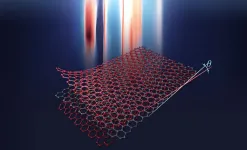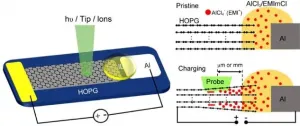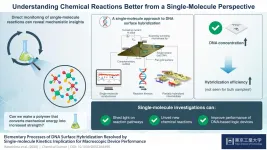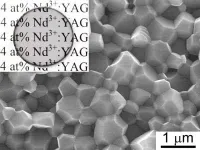Harvard scientists use trilayer graphene to observe more robust superconductivity
The new three-layer system opens the door for high temperature superconductors
2021-02-04
(Press-News.org) In 2018, the physics world was set ablaze with the discovery that when an ultrathin layer of carbon, called graphene, is stacked and twisted to a "magic angle," that new double layered structure converts into a superconductor, allowing electricity to flow without resistance or energy waste. Now, in a literal twist, Harvard scientists have expanded on that superconducting system by adding a third layer and rotating it, opening the door for continued advancements in graphene-based superconductivity.
The work is described in a new paper in Science and can one day help lead toward superconductors that operate at higher or even close to room temperature. These superconductors are considered the holy grail of condensed matter physics since they would allow for tremendous technological revolutions in many areas including electricity transmission, transportation, and quantum computing. Most superconductors today, including the double layered graphene structure, work only at ultracold temperatures.
"Superconductivity in twisted graphene provides physicists with an experimentally controllable and theoretically accessible model system where they can play with the system's properties to decode the secrets of high temperature superconductivity," said one of the paper's co-lead authors Andrew Zimmerman, a postdoctoral researcher in working in the lab of Harvard physicist Philip Kim.
Graphene is a one-atom-thick layer of carbon atoms that is 200 times stronger than steel yet is extremely flexible and lighter than paper. It has almost always been known to be a good conductor of heat and electrical current but is notoriously difficult to handle. Experiments unlocking the puzzle of twisted bilayer graphene have been ongoing since MIT physicist Pablo Jarillo-Herrero and his group pioneered the emerging field of "twistronics" with their experiment in 2018 where they produced the graphene superconductor by twisting it to a magic angle of 1.1 degrees.
The Harvard scientists report successfully stacking three sheets of graphene and then twisting each of them at that magic angle to produce a three-layered structure that is not only capable of superconductivity but does so more robustly and at higher temperatures than many of the double-stacked graphene. The new and improved system is also sensitive to an externally applied electric field that allows them to tune the level of superconductivity by adjusting the strength of that field.
"It enabled us to observe the superconductor in a new dimension and provided us with important clues about the mechanism that's driving the superconductivity," said the study's other lead author Zeyu Hao, a Ph.D. student in the Graduate School of Arts and Sciences also working in the Kim Group.
One of those mechanisms has the theorists really excited. The trilayer system showed evidence that its superconductivity is due to strong interactions between electrons as opposed to weak ones. If true, this can not only help open a path to high temperature superconductivity but possible applications in quantum computing.
"In most conventional superconductors, electrons move with a high speed and occasionally cross-paths and influence each other. In this case, we say their interaction effects are weak," said Eslam Khalaf, a co-author on the study and postdoctoral fellow working in the lab of Harvard physics professor Ashvin Vishwanath. "While weakly interacting superconductors are fragile and lose superconductivity when heated to a few Kelvins, strong coupling superconductors are much more resilient but much less understood. Realizing strong coupling superconductivity in a simple and tunable system such as trilayer could pave the way to finally develop a theoretical understanding of strongly-coupled superconductors to help realize the goal of a high temperature, maybe even room temperature, superconductor."
The researchers plan on continuing to explore the nature of this unusual superconductivity in further studies.
"The more we understand, the better we have chance to increase the superconducting transition temperatures," said Kim.
INFORMATION:
[Attachments] See images for this press release:

ELSE PRESS RELEASES FROM THIS DATE:
2021-02-04
Black children have significantly higher rates of shellfish and fish allergies than White children, in addition to having higher odds of wheat allergy, suggesting that race may play an important role in how children are affected by food allergies, researchers at Ann & Robert H. Lurie Children's Hospital of Chicago, Rush University Medical Center and two other hospitals have found.
Results of the study were published in the February issue of the Journal of Allergy and Clinical Immunology: In Practice.
"Food allergy is a common condition in the U.S., and we know from our previous research that there are important differences between Black and White children with food allergy, but there is so much we need to know to be able to help our patients ...
2021-02-04
In a new perspective piece published in the Feb. 5 issue of Science, pharmacologist Namandje Bumpus, Ph.D. -- who recently became the first African American woman to head a Johns Hopkins University School of Medicine department, and is the only African American woman leading a pharmacology department in the country -- outlines the molecular origins for differences in how well certain drugs work among distinct populations. She also lays out a four-part plan to improve the equity of drug development.
"Human beings are more similar than we are different," says Bumpus. "Yet, the slightest variations in our genetic material ...
2021-02-04
The COVID-19 pandemic has affected people's behavior everywhere. Fear, apprehensiveness, sadness, anxiety, and other troublesome feelings have become part of the daily lives of many families since the first cases of the disease were officially recorded early last year.
These turbulent feelings are often expressed in dreams reflecting a heavier burden of mental suffering, fear of contamination, stress caused by social distancing, and lack of physical contact with others. In addition, dream narratives in the period include a larger proportion of terms relating to cleanliness and contamination, as well as anger and sadness.
All this is reported in a study published in PLOS ONE. The principal investigator was Natália ...
2021-02-04
Surface and interface play critical roles in energy storage devices, thus calling for in-situ/operando methods to probe the electrified surface/interface. However, the commonly used in-situ/operando characterization techniques such as X-ray diffraction (XRD), transmission electron microscopy (TEM), X-ray spectroscopy and topography, and nuclear magnetic resonance (NMR) are based on the structural, electronic and chemical information in bulk region of the electrodes or electrolytes.
Surface science methodology including electron spectroscopy and scanning probe microscopy can provide rich information about how reactions ...
2021-02-04
Scientists globally aim to control chemical reactions--an ambitious goal that requires identifying the steps taken by initial reactants to arrive at the final products as the reaction takes place. While this dream remains to be realized, techniques for probing chemical reactions have become sufficiently advanced to render it possible. In fact, chemical reactions can now be monitored based on the change of electronic properties of a single molecule! Thanks to the scanning tunneling microscope (STM), this is also simple to accomplish. Why not then utilize ...
2021-02-04
Plastics are among the most successful materials of modern times. However, they also create a huge waste problem. Scientists from the University of Groningen (The Netherlands) and the East China University of Science and Technology (ECUST) in Shanghai produced different polymers from lipoic acid, a natural molecule. These polymers are easily depolymerized under mild conditions. Some 87 per cent of the monomers can be recovered in their pure form and re-used to make new polymers of virgin quality. The process is described in an article that was published in the journal Matter on 4 February.
A problem with recycling plastics is that it usually results in a lower-quality product. The best results are obtained by chemical recycling, in which the polymers are broken ...
2021-02-04
A pilot program to offer mental health services offered resident physicians at the University of Colorado School of Medicine provides a model for confidential and affordable help, according to an article published today by the journal Academic Medicine.
For the 2017-2018 class, 80 resident physicians in the internal medicine and in internal medicine-pediatrics programs were enrolled in a mental health program that provided scheduled appointments at the campus mental health center. Residents were allowed to opt-out of the appointments. The cost of the appointments was covered by the residency programs, not charged to residents. Programs received ...
2021-02-04
Scientists of Far Eastern Federal University (FEFU) have advanced the technology of high-speed sintering for optical ceramics (Nd3+:YAG), i.e. active elements generating laser emission in the near-infrared wavelength range (1.06 μm) for cutting the edge microelectronics and medicine. The researchers have managed to reduce significantly the initial nanopowders consolidation period (10 - 100 times) forming a nanostructure with ensured high optical transparency of the ceramic material. A related article appears in Optical Materials.
Diode-pumped ...
2021-02-04
Inflammation is supposed to help protect us--it's part of an immune response to fight off pathogens and clear infections. But patients with cardiac disease often have chronic inflammation that damages their hearts, even with no infection present.
In a recent study published in Circulation, immunologists at Tufts University School of Medicine in collaboration with investigators at Vanderbilt University and Tufts Medical Center revealed a mechanism that is activating T cells, a type of immune cell, and causing inflammation in the heart.
"Not all inflammation is the same," says Pilar Alcaide, a Kenneth and JoAnn G. Wellner Professor at Tufts School of Medicine and corresponding ...
2021-02-04
The 2019-2020 flu season in the U.S. was unusual in a number of ways. Cases picked up in August rather than the more typical fall and early winter months, and it hit children particularly hard. It was also dominated early on by a Type B influenza virus instead of one of the much more common Type A viruses like H1N1 or H3N2.
A new study by researchers at the University of Georgia suggests that these dynamics were driven largely by a new, more transmissible strain encountering a population with very little existing immunity to it.
Their findings, just published in the Proceedings of the National Academy of Sciences, have implications for future vaccination ...
LAST 30 PRESS RELEASES:
[Press-News.org] Harvard scientists use trilayer graphene to observe more robust superconductivity
The new three-layer system opens the door for high temperature superconductors





